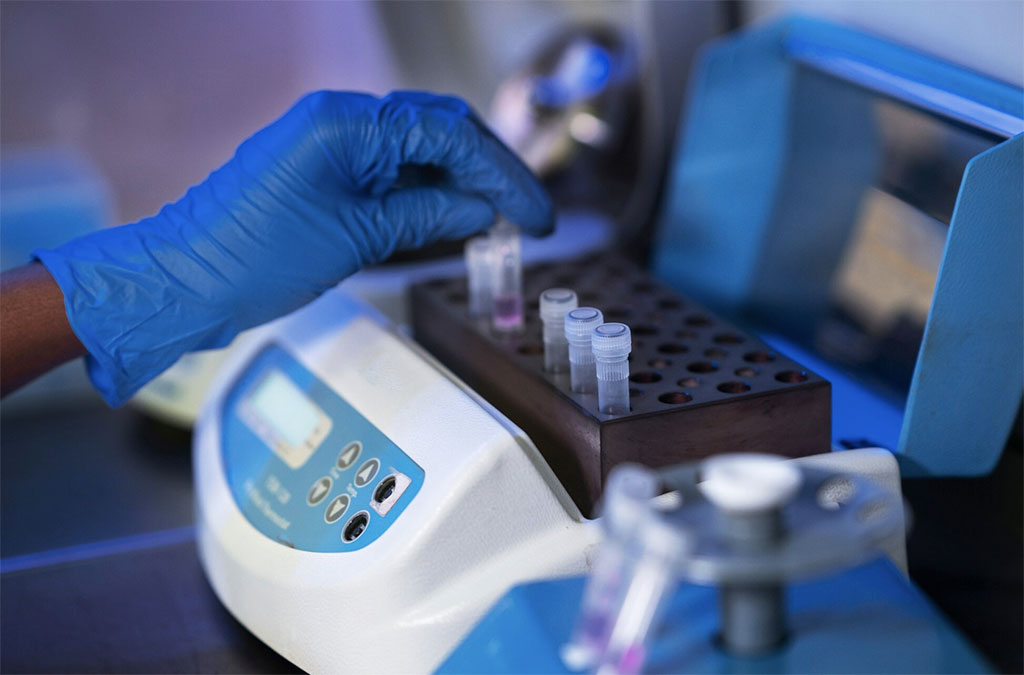Gravity-Powered Biomedical Device Paves Way for Low Cost POC Diagnostic Testing 
|
By LabMedica International staff writers Posted on 14 Jul 2023 |

The need for simple, user-friendly, point-of-care devices continues to exist. Many prototype and market-ready devices aim to simplify diagnosis and crucial biomarker measurement processes using minimal liquid samples, power, and professional knowledge. These innovations aim to enhance healthcare delivery for the vast population residing in low-resource locales, far from well-equipped hospitals and qualified medical personnel. These tests generally share certain prerequisites: they need to transport, combine, and assess minute biological sample-containing droplets and their active ingredients, enabling specific biomarker measurements. High-end devices employ miniature electric pumps to facilitate these reactions, while others leverage the dynamics of liquids within microchannels, or microfluidics, to produce a suction-like effect. Each method comes with its own distinct benefits and challenges. Now, researchers have demonstrated a first-of-its-kind approach that only uses gravity to power point-of-care biomedical devices and also offers certain advantages over currently existing platforms.
Biomedical engineers at Duke University (Durham, NC, USA) have devised a completely new approach for building point-of-care diagnostic tools, which only leverages gravity to transport, mix, and manipulate the liquid droplets involved. This proof-of-concept uses readily available materials and minimal power to interpret results, making it a potentially beneficial option for use in settings with limited resources. The innovative gravity-based technique is based on a selection of nine commercially available surface coatings that can fine-tune the wettability and slipperiness at any given point in the device, thereby controlling how much droplets spread into pancakes or remain spherical, while also influencing their ease of movement down an incline.
By using these surface coatings in smart combinations, all necessary microfluidic elements required for a point-of-care test can be generated. For instance, if a certain location is extremely slippery and a droplet is positioned at a juncture where one side pulls liquid flat and the other pushes it into a ball, it acts like a pump and accelerates the droplet toward the former. The scientists devised numerous elements to manage the motion, interaction, timing, and sequence of multiple droplets within the device. Merging these elements, they fabricated a prototype test to measure human serum lactate dehydrogenase (LDH) levels. They carved channels into the testing platform to create designated routes for droplet passage, each coated with a substance preventing droplets from sticking along the way. Specific points were also pre-treated with dried reagents needed for the test, which are absorbed by droplets of simple buffer solution as they traverse the channels.
The maze-like test is then sealed with a lid equipped with holes for the sample and buffer solution to be dripped in. Once filled, the test is inserted into a box-shaped device with a handle that rotates the test by 90 degrees, allowing gravity to take over. The device also features a simple LED and light detector for swift and easy color-based test result assessment. This enables the scientists to label three different biomarkers with distinct colors for varying tests. In the LDH prototype test, the biomarker is marked with a blue molecule. A basic microcontroller measures the depth of the blue tint and the rate of color change, signifying the quantity and concentration of LDH in the sample, to yield results. This novel demonstration presents a new approach to the development of affordable, low-energy, point-of-care diagnostic devices. While the team intends to further refine their concept, they also hope it will spark interest and lead to the creation of similar tests by other researchers.
“Most microfluidic devices need more than just capillary forces to operate,” said Ashutosh Chilkoti, the Alan L. Kaganov Distinguished Professor of Biomedical Engineering at Duke. “This approach is much simpler and also allows very complex fluid paths to be designed and operated, which is not easy or cheap to do with microfluidics.”
Related Links:
Duke University
Latest Technology News
- AI Saliva Sensor Enables Early Detection of Head and Neck Cancer
- AI-Powered Biosensor Technology to Enable Breath Test for Lung Cancer Detection
- AI Model Achieves Breakthrough Accuracy in Ovarian Cancer Detection
- Portable Biosensor Diagnoses Psychiatric Disorders Using Saliva Samples
- Cell-Sorting Device Uses Electromagnetic Levitation to Precisely Direct Cell Movement

- Embedded GPU Platform Enables Rapid Blood Profiling for POC Diagnostics
- Viral Biosensor Test Simultaneously Detects Hepatitis and HIV
- Acoustofluidic Device to Transform Point-Of-Care sEV-Based Diagnostics
- AI Algorithm Assesses Progressive Decline in Kidney Function
- Taste-Based Influenza Test Could Replace Nasal Swabs with Chewing Gum
- 3D Micro-Printed Sensors to Advance On-Chip Biosensing for Early Disease Detection
Channels
Clinical Chemistry
view channel
Chemical Imaging Probe Could Track and Treat Prostate Cancer
Prostate cancer remains a leading cause of illness and death among men, with many patients eventually developing resistance to standard hormone-blocking therapies. These drugs often lose effectiveness... Read more
Mismatch Between Two Common Kidney Function Tests Indicates Serious Health Problems
Creatinine has long been the standard for measuring kidney filtration, while cystatin C — a protein produced by all human cells — has been recommended as a complementary marker because it is influenced... Read moreMolecular Diagnostics
view channel
New Genetic Test Enables Faster Diagnosis of Rare Diseases
Rare disease diagnosis often involves a long and uncertain search for the underlying genetic cause. Traditional testing requires multiple separate analyses, although many patients remain without answers.... Read more
Urine Test Detects Inherited Neuropathy Missed by Genetic Screening
Sorbitol dehydrogenase (SORD)-related neuropathy is one of the most common inherited nerve disorders, yet diagnosis often lags because current genetic screens frequently miss the causal gene.... Read moreHematology
view channel
Platelet Activity Blood Test in Middle Age Could Identify Early Alzheimer’s Risk
Early detection of Alzheimer’s disease remains one of the biggest unmet needs in neurology, particularly because the biological changes underlying the disorder begin decades before memory symptoms appear.... Read more
Microvesicles Measurement Could Detect Vascular Injury in Sickle Cell Disease Patients
Assessing disease severity in sickle cell disease (SCD) remains challenging, especially when trying to predict hemolysis, vascular injury, and risk of complications such as vaso-occlusive crises.... Read more
ADLM’s New Coagulation Testing Guidance to Improve Care for Patients on Blood Thinners
Direct oral anticoagulants (DOACs) are one of the most common types of blood thinners. Patients take them to prevent a host of complications that could arise from blood clotting, including stroke, deep... Read moreImmunology
view channel
Chip Captures Cancer Cells from Blood to Help Select Right Breast Cancer Treatment
Ductal carcinoma in situ (DCIS) accounts for about a quarter of all breast cancer cases and generally carries a good prognosis. This non-invasive form of the disease may or may not become life-threatening.... Read more
Blood-Based Liquid Biopsy Model Analyzes Immunotherapy Effectiveness
Immunotherapy has revolutionized cancer care by harnessing the immune system to fight tumors, yet predicting who will benefit remains a major challenge. Many patients undergo costly and taxing treatment... Read moreMicrobiology
view channel
Blood-Based Molecular Signatures to Enable Rapid EPTB Diagnosis
Extrapulmonary tuberculosis (EPTB) remains difficult to diagnose and treat because it spreads beyond the lungs and lacks easily accessible biomarkers. Despite TB infecting 10 million people yearly, the... Read more
15-Minute Blood Test Diagnoses Life-Threatening Infections in Children
Distinguishing minor childhood illnesses from potentially life-threatening infections such as sepsis or meningitis remains a major challenge in emergency care. Traditional tests can take hours, leaving... Read more
High-Throughput Enteric Panels Detect Multiple GI Bacterial Infections from Single Stool Swab Sample
Gastrointestinal (GI) infections are among the most common causes of illness worldwide, leading to over 1.7 million deaths annually and placing a heavy burden on healthcare systems. Conventional diagnostic... Read morePathology
view channel
Blood Test and Sputum Analysis Predict Acute COPD Exacerbation
Chronic obstructive pulmonary disease (COPD) remains a major contributor to global illness, largely driven by cigarette smoking and marked by irreversible lung damage. Acute exacerbations can accelerate... Read more
AI Tool to Transform Skin Cancer Detection with Near-Perfect Accuracy
Melanoma continues to be one of the most difficult skin cancers to diagnose because it often resembles harmless moles or benign lesions. Traditional AI tools depend heavily on dermoscopic images alone,... Read more
Unique Immune Signatures Distinguish Rare Autoimmune Condition from Multiple Sclerosis
Myelin oligodendrocyte glycoprotein antibody–associated disease (MOGAD) is a rare autoimmune disorder in which the immune system attacks the myelin sheath in the central nervous system. Although symptoms... Read moreTechnology
view channel
AI Saliva Sensor Enables Early Detection of Head and Neck Cancer
Early detection of head and neck cancer remains difficult because the disease produces few or no symptoms in its earliest stages, and lesions often lie deep within the head or neck, where biopsy or endoscopy... Read more
AI-Powered Biosensor Technology to Enable Breath Test for Lung Cancer Detection
Detecting lung cancer early remains one of the biggest challenges in oncology, largely because current tools are invasive, expensive, or unable to identify the disease in its earliest phases.... Read moreIndustry
view channel
Abbott Acquires Cancer-Screening Company Exact Sciences
Abbott (Abbott Park, IL, USA) has entered into a definitive agreement to acquire Exact Sciences (Madison, WI, USA), enabling it to enter and lead in fast-growing cancer diagnostics segments.... Read more

























